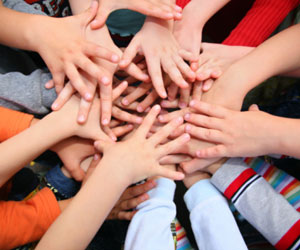Use of Gestures Reflects Language Instinct in Young Children
Young children instinctively use a “language-like” structure to communicate through gestures, according to research published in Psychological Science, a journal of the Association for Psychological Science.
 The research, led by the University of Warwick, shows that when young children are asked to use gestures to communicate, their gestures segment information and reorganize it into language-like sequences.
The research, led by the University of Warwick, shows that when young children are asked to use gestures to communicate, their gestures segment information and reorganize it into language-like sequences.
This finding suggests that children are not just learning language from older generations — their own preferences in communication may have shaped how languages look today.
Sotaro Kita from Warwick’s Department of Psychology led the study with Zanna Clay at the University of Neuchatel, Sally Pople at the Royal Hampshire Hospital, and Bruce Hood at the University of Bristol.
The research team examined how 4-year-olds, 12-year-olds, and adults used gestures to communicate in the absence of speech.
The aim of the study was to investigate whether, when gesturing, the participants chose to break down complex information into simpler concepts. Doing so would be similar to the way we typically express complex information using language, breaking it down into units (such as words) to express simpler concepts and then stringing those units together into a phrase or sentence.
The researchers showed the participants animations of events involving motion, depicting either a smiling square or circle that moved up or down a slope in a particular manner (e.g., jumping or rolling).
The participants were asked to use their hands to mime the action they saw on the screen without speaking. The researchers examined whether the upward or downward path and the manner of motion were expressed simultaneously in a single gesture or expressed in two separated gestures depicting its manner or path.
“Compared to the 12-year-olds and the adults, the 4-year-olds showed the strongest tendencies to break down the manner of motion and the path of motion into two separate gestures, even though the manner and path were simultaneous in the original event,” said study author Sotaro Kita.
“This means the 4-year-olds’ miming was more language-like, breaking down complex information into simpler units and expressing one piece of information at a time,” Kita explained. “Just as young children are good at learning languages, they also tend to make their communication look more like a language.”
“Previous studies of sign languages created by deaf children have shown that young children use gestures to segment information and to re-organize it into language-like sequences,” said study co-author Zanna Clay. “We wanted to examine whether hearing children are also more likely to use gesture to communicate the features of an event in segmented ways when compared to adolescents and adults.”
The researchers suggest the study provides insight into why languages of the world have universal properties.
“All languages of the world break down complex information into simpler units, like words, and express them one by one. This may be because all languages have been learned by, therefore shaped by, young children. In other words, generations of young children’s preference for communication may have shaped how languages look today,” Kita added.





APS regularly opens certain online articles for discussion on our website. Effective February 2021, you must be a logged-in APS member to post comments. By posting a comment, you agree to our Community Guidelines and the display of your profile information, including your name and affiliation. Any opinions, findings, conclusions, or recommendations present in article comments are those of the writers and do not necessarily reflect the views of APS or the article’s author. For more information, please see our Community Guidelines.
Please login with your APS account to comment.